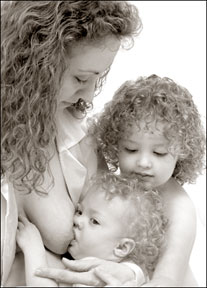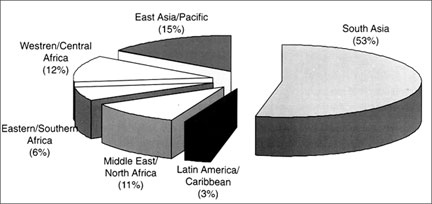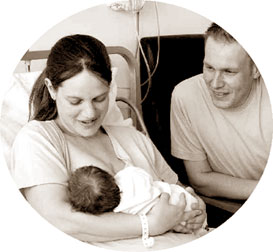|

"I know what's best for my baby"
Breastfeeding
by Shanika Sriyananda in New Delhi
 In this era which we witness vast improvement in technology and enjoy
the electronic wonders in every segment, we still hear shocking news of
millions of infants dying without a drop of milk, pricking the hearts of
millions. In this era which we witness vast improvement in technology and enjoy
the electronic wonders in every segment, we still hear shocking news of
millions of infants dying without a drop of milk, pricking the hearts of
millions.
Tiny tots like walking skeletons are still screaming for a grain of
rice. Amidst the gloomy picture of these unfortunate children, the
countries in which they are born, boasts of several achievements
including excellent economic growth, novel inventions and increase in
health indicators.
However, it was shocking to hear that over 1.4 billion babies in the
South Asian region die before they could complete the first month of
their arrival in this world. And... another 2.2 million babies leave
same world between the ages of two to 12 months. The main killer is the
infant and young child malnutrition, which is mainly due to
inappropriate feeding practices.
So...what are the ways to reduce infant mortality.
The answer is simple but the benefits derived from it are long-term.
It is the BREASTFEEDING which every mother is encouraged to do to make
their children healthy.
Is it the responsibility solely to be borne by the mothers "No, not
only the mothers but there is a great need to receive support from the
family as well as the community, to continue breast feeding the
infants", Dr. Arun Gupta, the Regional Coordinator of the South Asia
Breastfeeding Partners Forum said.
According to Dr. Gupta, improving breastfeeding practice needs
behavioural change, something that does not happen spontaneously and
without encouragement. " This requires a shift in thinking from 'food
based' approaches towards 'family based' feeding behaviour", he said.
The prominent paedatricians and high governmental and NGO officials
from the South Asian countries - Afganistan, Bhutan,
India,Maldives,Nepal,Pakistan and Sri Lanka - who took part in the Forum
which was held under the theme of 'Save babies: Support women to
breastfeed', highlighted the need for universalising optimal
breastfeeding practices - beginning breastfeeding within an hour,
exclusive breastfeeding for the first six months and continue
breastfeeding for two years or beyond along with adequate and
appropriate complementary feeding.
The Millennium Development Goals (MDGs) target to reduce deaths of
Under five years olds by a two third by 2015 but the experts stressed
the need of setting up new time frame for the SARRC countries prior to
the MDGs time frame, as the world's highest number of infant deaths in
the world are recorded in this region.
"So the region needs to scale up the action on breastfeeding faster.
But this cannot be achieved if women are not supported to breastfeed
optimally. If women have to practise optimal breastfeeding, they need
support from all stakeholders - the father, family, the community and
the State.
It is time to create a new world for children and their mothers,
where women can breastfeed successfully in an atmosphere of love, caring
and sharing to have a healthy child population", they stressed.
"South Asia which has about 1.4 billion people, has the highest
number of Under-five deaths and Under-five children who are underweight.
Out of total 146 million Under-five underweight children 70 million are
in the South Asia and they are unlikely to achieve their full growth and
potential development", Dr. Gupta said adding that early breastfeeding
within one hour and exclusive brastfeeding for the first six months is
the key to tackle infant malnutrition and also the survival of infants
and young children.
Dr. Gupta said that despite the known advantages of breastfeeding
there are long-term advantages over artificial feeding.
 Its benefits for mothers and children for long-term outcomes of adult
health, reducing obesity, neonatal infections, diarrhoea and respiratory
illnesses. Malnutrition impairs mental and physical development in kids
and makes them more susceptical to illnesses. Its benefits for mothers and children for long-term outcomes of adult
health, reducing obesity, neonatal infections, diarrhoea and respiratory
illnesses. Malnutrition impairs mental and physical development in kids
and makes them more susceptical to illnesses.
According to the World Health Organization (WHO)'s infant feeding
guidelines recommend that infants should begin breast feeding within one
hour, be exclusively breastfed for the first six months of life to
achieve optimal nutrition, survival, growth and development.
Thereafter, to meet their evolving nutritional requirements, infants
should receive appropriate and adequate complementary feeding while
breastfeeding continues for up to two years of age or beyond. These
interventions are critical to infant and young child mortality.
Citing an example Dr. Gupta said that Lancet series on child survival
and alter newborn survival showed that 13% to 15% of under-five deaths
in resource poor countries could be prevented through achievement of 90%
coverage with exclusive breastfeeding alone. And additional 6% could be
prevented with appropriate complementary feeding.
He said that half of diarrhoea deaths are attributed to sub optimal
breastfeeding and global ecological risk assessment of deaths and years
of life lost due to suboptimal breastfeeding among children in the
developing world revealed that attributable fractions for deaths due to
diarrhoeal disease and lower respiratory tract infections are 55% and
53%, respectively, for the first six months of infancy, 20% and 18% for
the second six months, and are 20% for all-cause deaths in the second
year of life.
The authors concluded that globally, as many as over 1.45 million
lives (117 million years of life) are lost due to suboptimal
breastfeeding in developing countries. This WHO Study further justifies
focus on nutrition interventions being mainstreamed.
He also said that beginning breastfeeding within first hour cuts
newborn deaths by 22% and a study carried out in Ghana clearly showed,
for the first time in the world, an association between timing of
breastfeeding and newborn survival.
The study showed that 22% of all neonatal deaths could be prevented
if all women could initiate breastfeeding within one hour of birth.
Further analysis now suggests that this figure could be as high as 31%.
An epidemiologic evidence of a causal association between early
breastfeeding and infection specific mortality in the newborn infants
published recently in the American Journal of Clinical Nutrition showed
that those newborns in Ghana, who initiated breastfeeding within 1 hour,
were less likely to die of neonatal sepsis than those who didn't.
Risk of infection deaths increased with increasing delay in
initiation of breastfeeding from one hour to seven days overall late
initiation (after day 1) was associated with a 2.6-fold risk.
Additionally, partial breastfeeding during first month was associated
with a 5.7-fold adjusted risk of death as a result of infectious disease
after adjusting with the effect of early breastfeeding. That means early
as well as exclusive breastfeeding both are significantly associated
with reduced infection-specific neonatal mortality in young infants.
WHO provides clear evidence of optimal breastfeeding and its links to
adult health and IQ (2007).
Another WHO systematic meta-analysis conducted to assess the
association between breastfeeding and blood pressure, diabetes and
related indicators, serum cholesterol, overweight and obesity, and
intellectual performance has found that who were breastfed experienced
lower mean blood pressure and a higher performance in intelligence
tests.
Prevalence of overweight/obesity and type-2 diabetes was lower among
breastfed subjects. All effects were statistically significant but for
some outcomes their magnitude was relatively modest.
Dr. Gupta said that the exclusive breatfeeding can cut down HIV
transmission rates from HIV positive women to their offspring by half.
The new intervention cohort study from South Africa, assessed the HIV-1
transmission risks and survival associated with exclusive breastfeeding
and other types of infant feeding in HIV positive women.
Risk of acquisition of infection at six months of age via exclusive
breastfeeding was 4.04%. Breasted infants who received some solids had
11 times higher risk infection and if other milk or formula is given
along with breastfeeding the risk could almost double.
The study showed that HIV free infant survival was much higher in
exclusively breastfed children at 3 months.
According to WHO about two-thirds of all child deaths occur during
infancy, and related to sub optimal feeding practices.
****
A correct attachment is crucial to success
The trick to successful breastfeeding is getting the baby to suckle
in correct position at the breast or 'latch on' well. This way it helps
effective transfer of mother's milk from a mother to her baby.
The baby should take enough of areola (the brownish area around the
nipple) into the mouth for maximizing milk transfer. This is essential
because breastmilk is stored in ducts under areola. A correctly attached
baby takes the nipple as well as the areola inside the mouth and uses
suction to pull out the breast tissue to form a teat.
This stimulates production of two hormones. One, prolactin that is
responsible for milk secretion from the glands, and two oxytocin, which
makes milk flow from ducts in the breast into the baby's mouth.
Therefore, effective suckling is what controls the whole process of
milk production and milk transfer. As the baby sucks and takes out milk,
the breasts start making more milk. More suckling makes more milk.
***
How does it benefit baby and the mother?
|

Husband’s support is vital too
|
It ensures the intake of first milk from the breast, which is thick
and yellowish in colour (colostrum), as the first feed which provides
protection against infection (called first immunization of the baby),
the other benefits are:
* Early initiation builds on the baby's innate reflexes. Babies who
start breastfeeding at this time continue to breastfeed exclusively and
thus adopt optimal feeding practices later.
* The baby learns to recognise his/her mother's smell.
* The baby is calmer and his/her breathing and heart rate are
steadier.
* The process of emotional bonding starts.
* The mother's body helps to keep the baby warm, especially important
for small and low birth weight babies and saving them from hypothermia,
one of the important causes of deaths.
* The mother's body produces the hormone oxytocin and the flow of
milk is enhanced.
* The mother's commensal (normal) bacteria start colonizing the
baby's skin and gut, which helps to protect the baby against the harmful
bacteria in the environment.
* Early initiation of breastfeeding has also been shown to help
reduce post-partum bleeding, a major cause of maternal mortality in
developing countries.
Take the advantage of feeding the baby with colostrum
Colostrum, the sticky, yellowish-white milk is available for first
3-5 days and is eventually replaced by mature milk. It has high levels
of antibodies, vitamin A, vitamin K and other protective factors, and
thus is called babies' first immunization.
Although colostrum is secreted in small quantities (30-90 ml), it is
sufficient to meet the energy requirements of normal newborns during the
first few days of life. Thus, in the first few days the requirement of
the baby is little and is met by even a few minutes of suckling at the
breast.
****
What is the magical milk...
* Mother's milk is complete nutrition for the baby from birth upto
4-6 months. No other milk, food or drink is required.
* Babies should start to breastfeed within 1/2 to 1 hour of birth.
They should get colostrum - the yellowish milk during first 2-3 days.
Nothing should be given before the first breastfeed.
* Bottlefeeding is unnecessary and even harmful for babies. It is the
leading cause of diarrhoea in babies.
* Mother can continue breastfeeding during sickness without any harm
to the baby.
* Commercial milks are always inferior to mother's milk.
* Solid foods should be introduced after 4 months but not later than
6 months of age.
* Breastfeeding should be continued well into the second year of
life.
* Practically all mothers can successfully breastfeed their babies. |
